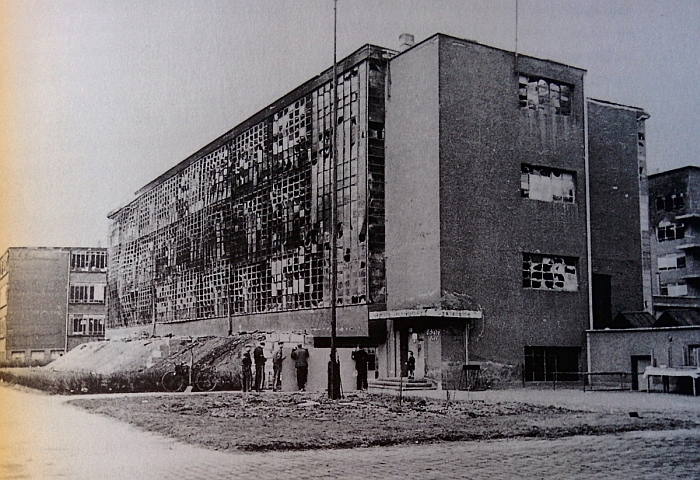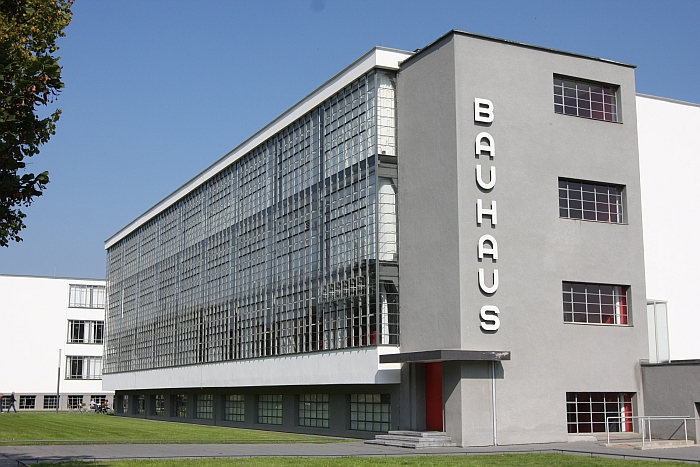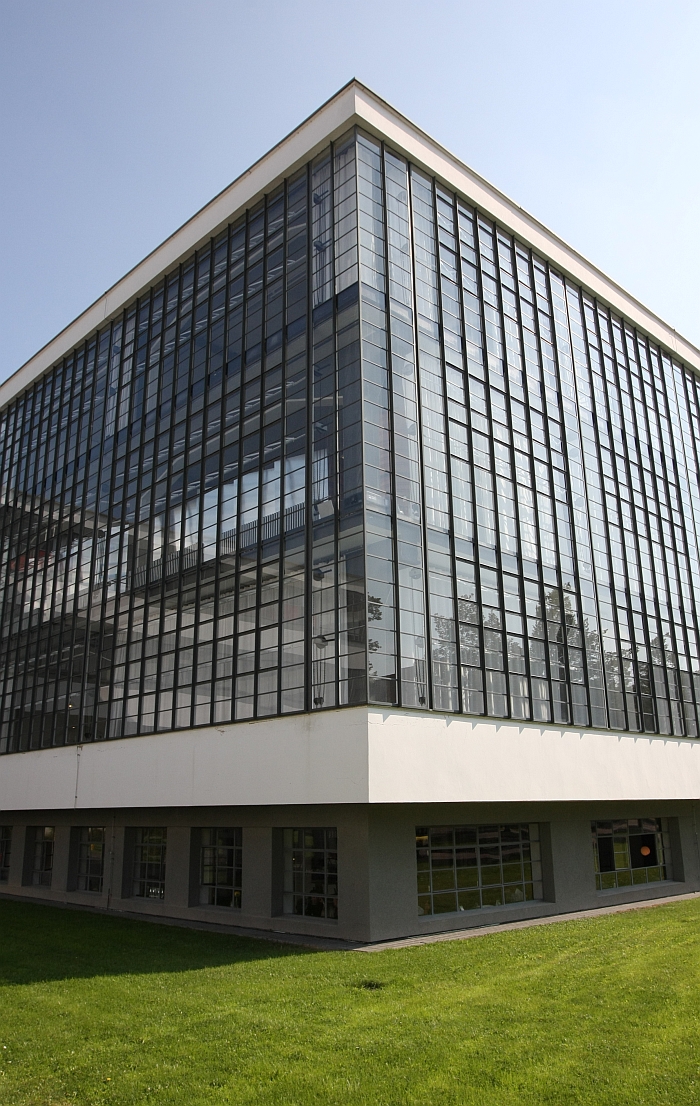Bauhaus in East Germany: The Formalism Debate
Bauhaus Dessau was officially opened on December 4th 1926, and by way of celebrating the institution’s 90th anniversary on December 4th 2016 the foundation stone will be laid for the new Bauhaus Museum Dessau; an act which comes just one month after the foundation stone was laid for the new Bauhaus Museum Weimar. Both museums being built in preparation for the coming centenary of Bauhaus’s 1919 inauguration.
An apposite moment we thought to reflect on how Bauhaus was received, or at least how it was received in the early years, in its new, old, East German home1
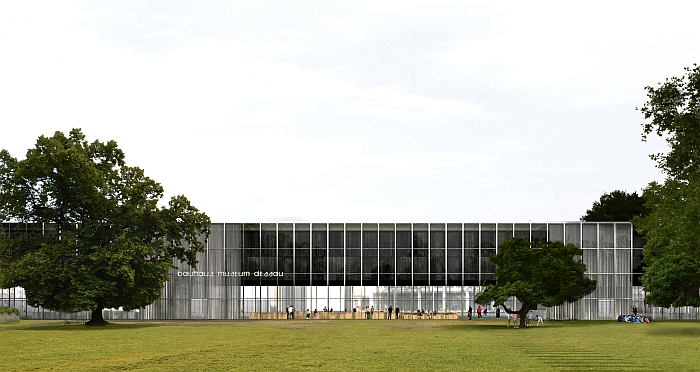
The planned new Bauhaus Museum Dessau, view from Stadtpark (Image © Gonzalez Hinz Zabala courtesy Stiftung Bauhaus Dessau)
Bauhaus in East Germany: The Immediate Post-War Years
Fate being famously fickle, the two most important Bauhaus locations, Weimar and Dessau, found themselves post-war in East Germany2, and theoretically Bauhaus was exactly what the young East Germany needed: many of the principles of international modernism, and much of the philosophy underscoring Bauhaus being, theoretically, perfect for the large scale reconstruction and re-equipping needed post-war, and that in a form which was durable and sustainable over the coming decades.
Or as the East German art historian Lothar Lang notes in his 1965 book Das Bauhaus 1919 – 1933. Idee und Wirklichkeit [The Bauhaus 1919 – 1933. Idea and Reality], “…rarely disputed is their pioneering influence on architecture and industrial design, including the associated positive consequences for housing, the form of everyday implements, and their useful advice and models for industrial manufacture, including, and to name only some, lighting, wallpaper, ceramics and steel tube furniture”3
And initially it appeared that East Germany had grasped that, certainly the newspaper coverage of Bauhaus in the immediate post-war years regularly recommending it as a reference for the future, not necessarily as a 1:1, but certainly in terms of “what can we learn from”. In 1948 the Berliner Zeitung, concerned as it obviously was about the misuse of resources for “wantonly tasteless arts and crafts”, and that in a time of resource scarcity, opined that, “The Bauhaus could play a beneficial role today in the creation of a new, modest yet beautiful, domestic culture.”4 The same article also noting that “The news of the imminent reopening of the Dessau Bauhaus was welcomed by many”, and indeed there was, an albeit short-lived, plan for re-opening Bauhaus Dessau: a plan largely driven by the ex-Bauhäusler, and post-war city planner in Dessau, Hubert Hoffmann, but a plan which, as with those for a from Hoffmann initiated Bauhaus exhibition, was abandoned on account of political disagreements.
In addition, when Walter Gropius visited Berlin in August 1947 the East German press reported fully and positively on his thoughts concerning the post-war reconstruction, even allowing him to make a little PR for the modular construction system which at that time he and Konrad Wachsmann were developing in America, and which Gropius considered perfectly suited to Germany’s contemporary problems. Surrounded by the ruins of Berlin Gropius is quoted in one report as saying, “… today we can no longer look backwards to the style of Romanticism or Gothic. A new architectural style will have to be found, one which reflects the spirit of the times”5
Which is one of those sentences which carries a whole lot more pathos when read with the benefit of hindsight.
For even as Gropius was advancing such thoughts, the atmosphere was changing, and whereas in 1965 Lothar Lang was free to use a phrase such as “rarely disputed” a decade or so earlier Bauhaus was not only disputed in East Germany, but actively demonised.
Bauhaus – “A Hostile Manifestation”
In the late 1940s a debate about the nature and direction of contemporary art slowly began to creep through eastern German cultural and political circles. A debate which largely focussed on extolling the virtues of a realism in art, of art which had narrative content, ideally one which positively reflected the daily toils of the worker, and degenerating more formal tendencies, of art which focussed on form over content.
And a debate which, and as with as much in the history of post-war Eastern Europe, had its origins in Moscow; specifically discussions concerning formalism versus realism in Russian art which began in the 1930s, paused briefly for the war, before continuing again.
Anne-Kathrin Weise notes that “… in October 1946 on occasion of the Saxony Artists Congress in Dresden, demands for realistic art weren’t pressing, but discussions concerning realism and formalism were held, if only in small groups”6
Discussions which became ever more pressing, ever wider, and by the occasion of the 3rd Party Conference the ruling SED in July 1950 formalism had become an “alien and hostile movement” and a “weapon of imperialism”, the resolution also noting that “formalistic tendencies are particularly prevalent in architecture and ignore the true needs of the workers.”7
As perhaps the most obvious and best known representatives of formalistic tendencies, Bauhaus and Bauhäusler were a favourite target of the East German authorities.
On October 31st 1951 the, then, Assistant Prime Minister and General Secretary of the SED Walter Ulbricht denounced the “Bauhaus style” in a speech before the Volkskammer as a “hostile manifestation”8, and continued his theme on December 8th 1951 on the occasion of the opening of the Deutschen Bauakademie, an institution established to lead the reconstruction effort, and that in a form which “should exist to serve the working people.” After announcing that “the formalism of the so-called Bauhaus style, and functionalism, which is especially promoted by the Americans in West Germany, has led architecture along dead-ends”, Ulbricht decried, “formalism asserts that it is impossible to shape the great ideas of the age in architecture. Alone the function and construction of the building determine the shape of a building. The director of the so-called Dessau Bauhaus, Hannes Meyer, declared that one could no longer speak of architecture, but only of construction in general”9
Thus at that very moment when the East German leadership could, arguably should, have been celebrating 25 years since the founding of Bauhaus Dessau and thus, more or less, 25 years since Bauhaus began to connect craft with industry, and by extrapolation 25 years since a new understanding of architecture and design and a new creative energy, spread from their small region of Europe to the rest of the world, and by further extrapolation how 25 years later that understanding and creative energy, infused and enriched as it was by its global experiences, could now be brought back and used to help revitalise their small region of Europe. They were damning it to hell in a handcart.
Few peoples bring us closer to the brink of despair than East Germans.
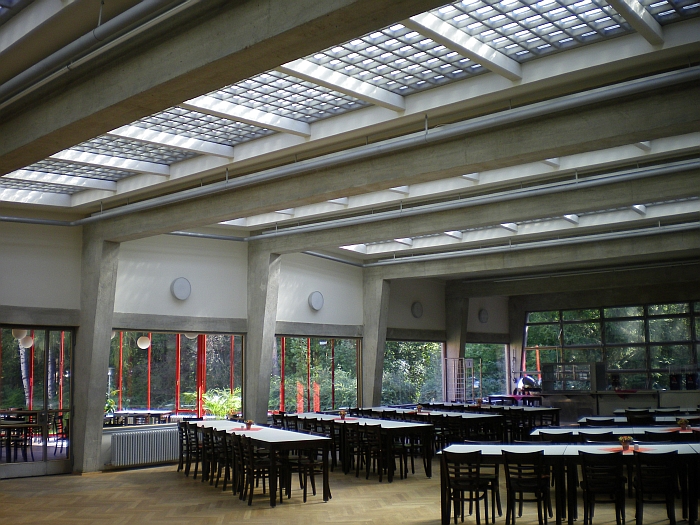
The ADGB Bundesschule in Bernau near Berlin by the “director of the so-called Dessau Bauhaus, Hannes Meyer”
Form Follows Dogma
While it is easy, almost too easy, to accuse the East Germany authorities of simply following Moscow’s lead, which they were, one must also view developments in their wider context.
For all the fact that East Germany didn’t formally exist until October 1949. Before that the region was known as the Soviet Occupation Zone, and the idea of a unified Germany hadn’t been completely ruled out. Having been ruled out with the monetary reforms of 1948 and subsequent establishment of East and West Germany, the newly formed East Germany needed not only a way to differentiate itself from West Germany, but also needed to establish a sense of tradition, a national identity. And that obviously couldn’t be connected or in any way related to the capitalist West.
Thus, and very much like a teenager attempting to establish their own identity independent of their parents, and thus of the common heritage implied therein, the East German authorities rejected everything that stood for the decadent, cosmopolitan, imperialism of West Germany.
And that, amongst many other things, meant formalism. And Bauhaus.
Which in terms of architecture and design meant that while form should still follow function, the definition of function shifted from “use” to dogmatically reflecting a politically decreed concept of what represents an ideologically sound eastern Germany tradition and cultural identity.
Which is not only less catchy. But was also a lot less practical.
In terms of architecture meaning as it, more or less, did, a return to Neoclassicism, to monumental, representative works, of which the Stalinallee, the contemporary Karl-Marx-Allee10, in Berlin is unquestionably the classic example, and buildings which thus exist in contrast to what Walter Ulbricht refers to as the “quadratic high-rise buildings” of the Americans/West Germans, “these concrete boxes are the expression of formalism’s inability to generate new ideas for the construction industry”11
Similarly, in terms of furniture and interiors instead of quickly producible, easily installed, resource light, cost efficient solutions, the East German authorities wanted solid, ornate, almost heroic folkloric objects, because, as Rudolf Horn, at that time a student in Dresden and later one of the more notable, and functionalistic, East German designers, told us, “it was all about the workers, the new class, who were now in power, it was about creating something new for the workers so that they realised that they are important. And that was to be demonstrated with richly decorated furnishings, not with simple boxes.“
The “simple boxes” did however eventually come. In furniture and architecture. As did a, gradual, rehabilitation of Bauhaus.
As with the rise of the formalism debate its ebbing had its origins in Moscow. Or more specifically the Kuntsevo district of Moscow where on March the 5th 1953 Joseph Stalin died.
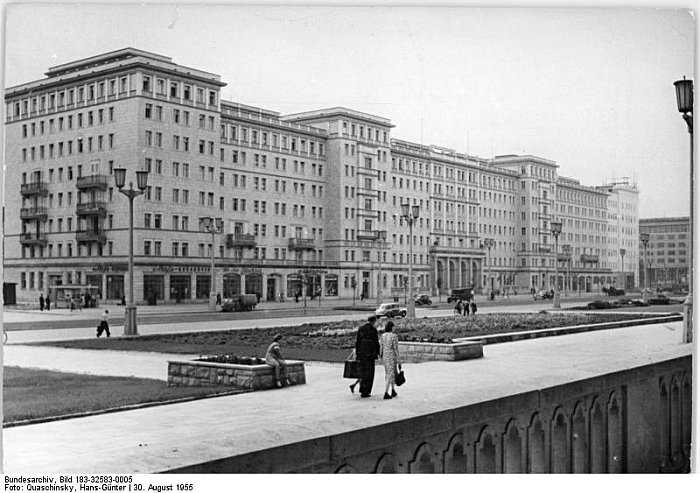
Stalinallee Berlin ca. 1955 (Photo Bundesarchiv, Bild 183-32583-0005 / CC-BY-SA 3.0 Source https://commons.wikimedia.org)
Bauhaus in East Germany: The Slow Rehabilitation
The death of Stalin resulted in major changes in Soviet domestic and foreign policy, including Moscow’s official position on architecture and urban planning. Whereas under Stalin historic, Russian, non-formalist, non-constructivist, values had been demanded, his successor Nikita Khrushchev advanced a more pragmatic position, and at the Conference of Soviet Construction Experts in December 1954 announced a move towards a greater industrialisation and standardisation of construction in order to achieve better quality buildings at a more rapid tempo and lower cost. Or “Better, cheaper and faster construction” to quote the motto of the speech.12
Although as Andreas Schätzke notes the response of the East German government was, somewhat, hesitant, by April 1955 Walter Ulbricht was repeating Khrushchev’s demands, telling the Construction Conference of the Deutschen Demokratischen Republik, “The central theme and responsibility of this conference is: “Better, faster and cheaper construction!”13
Walter Ulbricht’s plasticity on matters of architecture and construction should come as no surprise, he was after all the man who famously said “No-one is planning to build a wall.” Before doing just that.
Thus from the mid 1950s onwards, and in a perfect demonstration of the art of doublethink, East Germany quietly forget about the evils of formalism and the so-called Bauhaus style and slowly began to embrace, or perhaps better put, re-embrace, much of the ideas on architecture and design developed in the inter-war years. So much so that by the 50th anniversary of the opening of Bauhaus Dessau in 1976 Karl-Albert Fuchs, the then Rector of the Hochschule für Architektur und Bauwesen Weimar could confidently predict, “We are certain that this [Bauhaus] heritage will increasingly play an active role in solving the beautiful and challenging tasks facing the town planners, architects and designers of our republic”14
Which isn’t to say that formalism debate wasn’t without it longer-term consequences. Either as a direct result of the formalism debate, or because the formalism debate made working as a designer and architect more complicated, if not impossible, East Germany lost more talented, innovative contemporary designers and architects than it could probably have afforded to, among the more notable being Wilhelm Wagenfeld, Herbert Hirche, Gustav Hassenpflug, Marianne Brandt, Hans Scharoun and perhaps most tragically Mart Stam – who in 1948 swapped Holland for East Germany specifically to help the fledgling socialist state. And ended up being demonised. Or as Ernst Hoffmann, the 2nd Secretary the Berlin SED, announced in 1951, “…Genosse Stam, is a formalist…”15
Bauhaus in East Germany. Or, Lessons on the Misuse of Culture for Political Means
Reading the material from the 1940s and 50s one is struck on the one hand, and with the safety and benefit of six decades hindsight, just how much of the criticism of formalism sounds like, well, praise.
And on the other the delicious irony contained in almost every word spoken and/or written: irony in the fact that having been effectively closed by a right wing regime Bauhaus found itself posthumously under attack from a left wing regime; irony in terms of the closeness of the language to that of the nazis when they denounced creative movements they considered ungermanic, including the language used when criticising Bauhaus; and irony in the belief that what originates in the distant past is more advanced that which developed in the recent past, even though that which developed in the recent past is largely based on what originated in the distant past.
But then dictatorships, left wing or right, have never been known for their prodigious sense of irony. Which is a shame because if they possessed such they would realise their own absurdity and disband.
Yet next to the irony sits the unpalatable realisation that the basis of a lot of the formalism criticism was simply false. That the criticism was largely based on arguments which couldn’t be substantiated, arguments which either ignored reality or created a logical and plausible solution to a non-existent reality. Yet arguments which when repeated often enough became fact amongst a population either unwilling or unable to question the distortion.
A distortion which was intended to help cement political power. A distortion which used culture as a tool in place of political argument. A distortion which relied on the concept of a cultural hierarchy rather than a cultural equality. A distortion which sought its ends through demonisation rather than convincing. A distortion not used for the first time. And a distortion which still exists today.
Consequently the formalism debate reminds us not only that “Bauhaus” isn’t, and never was, a “style”, but part of a long evolution of the question of how best to respond to changing social, cultural and economic conditions, and that while one needn’t like what Bauhaus did and thought, responding to it means accepting it and its place in said evolution. While at the same time the formalism debate reminds us of the dangers of letting culture be misused. Of letting culture become synonymous with identity. Of not challenging those who misuse cultural for their own political ends.
And so it is to be hoped that alongside all the cantilever chairs, lamps, wallpaper, costumes, photography and architecture the new Bauhaus Museum Dessau will invariably display, that they also find space for an exploration of that post-war period when Dessau was a lot less keen to associate itself with its most famous building.
1. Our principle focus is architecture and design. Clearly the history in terms of art, theatre, photography etc, etc, etc is just as interesting, important and relevant. Is however far, far to wide a scope for such a post
2. Bauhaus Berlin technically did as as well, however Bauhaus Berlin was in the future West Sector of the city. And never really, properly, entered operation
3. Lothar Lang, Das Bauhaus 1919 – 1933: Idee und Wirklichkeit, Zentralinstitut für Formgestaltung, Berlin, 1965.
4. “Kitschgewerbe oder Gebrauchsgerät? Ist das Bauhaus überlebt? / Wie steht es mit seiner Wiedereröffnung?”, Berliner Zeitung, Berlin, 29.04.1948
5. “Neue deutsche Baukunst? Gespräch mit Prof. Gropius”, Neue Zeit, Berlin, 12.08.1947
6. Anne-Kathrin Weise, Leben und Werk von Marianne Brandt ausführliche Biographie mit der Analyse ihres Werkes, Bibliographie, Werkverzeichnis, PhD Dissertation, Humboldt University Berlin, 1996
7. Hans Lauter, “Der Kampf gegen den Formalismus in Kunst und Literatur, für eine fortschrittliche deutsche Kultur. 5 Tagung des Zentralkomitees der SED vom 15-17 März 1951”, Dietz Verlag, Berlin, 1951
8. Walter Ulbricht: Kunst und Wissenschaft im Plan. Rede vor der Volkskammer 31.10.1951 quoted in Andreas Schätzke, Zwischen Bauhaus und Stalinallee: Architekturdiskussion im östlichen Deutschland 1945 – 1955, Vieweg Verlag, Braunschweig, 1991
9. “Das Nationale Aufbauwerk und die Aufgaben der deutschen Architektur” in Die Aufgaben der Deutschen Bauakademie im Kampf um eine deutsche Architektur, Henschelverlag Berlin, 1952
10. There is great irony in the new name in that while Stalin was behind much of the criticism of formalism, the writings of Marx were often quoted to back up the criticism…
11. “Das Nationale Aufbauwerk und die Aufgaben der deutschen Architektur” in Die Aufgaben der Deutschen Bauakademie im Kampf um eine deutsche Architektur, Henschelverlag Berlin, 1952
12. Quoted in Andreas Schätzke, Zwischen Bauhaus und Stalinallee: Architekturdiskussion im östlichen Deutschland 1945 – 1955, Vieweg Verlag, Braunschweig, 1991
14. Karl-Albert Fuchs, Die Stellung des Bauhauses in der Geschichte und die Bedeutung seines Erbes für die entwickelte sozialistische Gesellschaft: Hauptvortrag zum Bauhaus-Kolloquium, Weimar, Oktober 1976, Wissenschaftliche Zeitschrift, Hochschule für Architektur und Bauwesen Weimar, Volume 23, Nr. 5/6, 1976
15. Hans Lauter, “Der Kampf gegen den Formalismus in Kunst und Literatur, für eine fortschrittliche deutsche Kultur. 5 Tagung des Zentralkomitees der SED vom 15-17 März 1951”, Dietz Verlag, Berlin, 1951
Tagged with: Bauhaus, DDR, Dessau, East Germany, Formalism Debate
